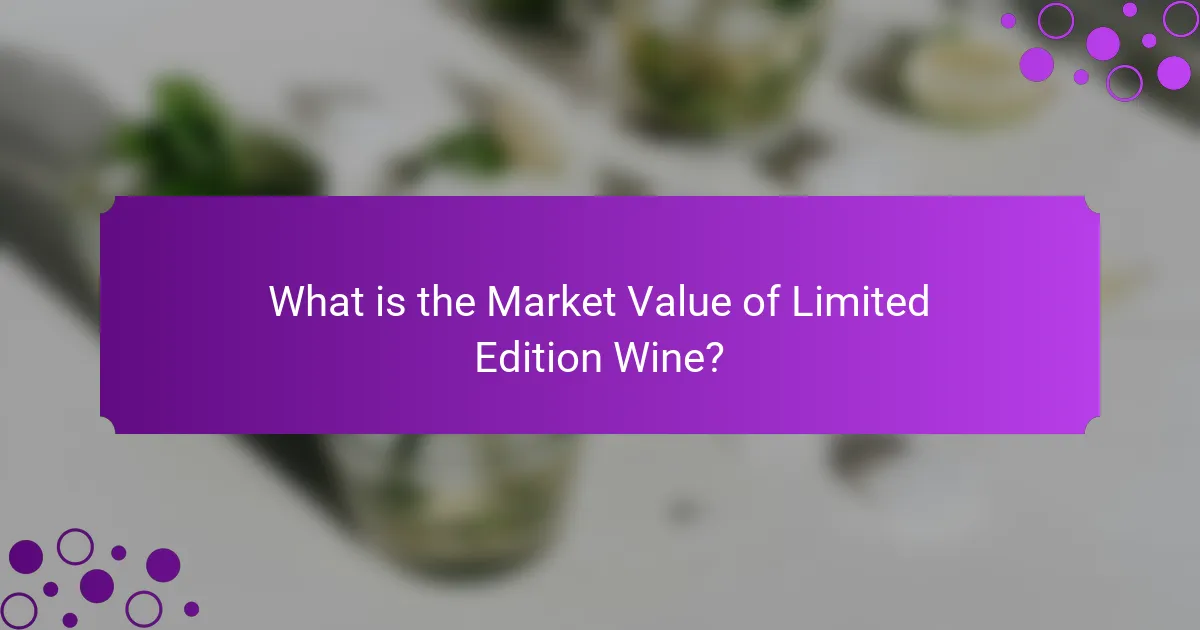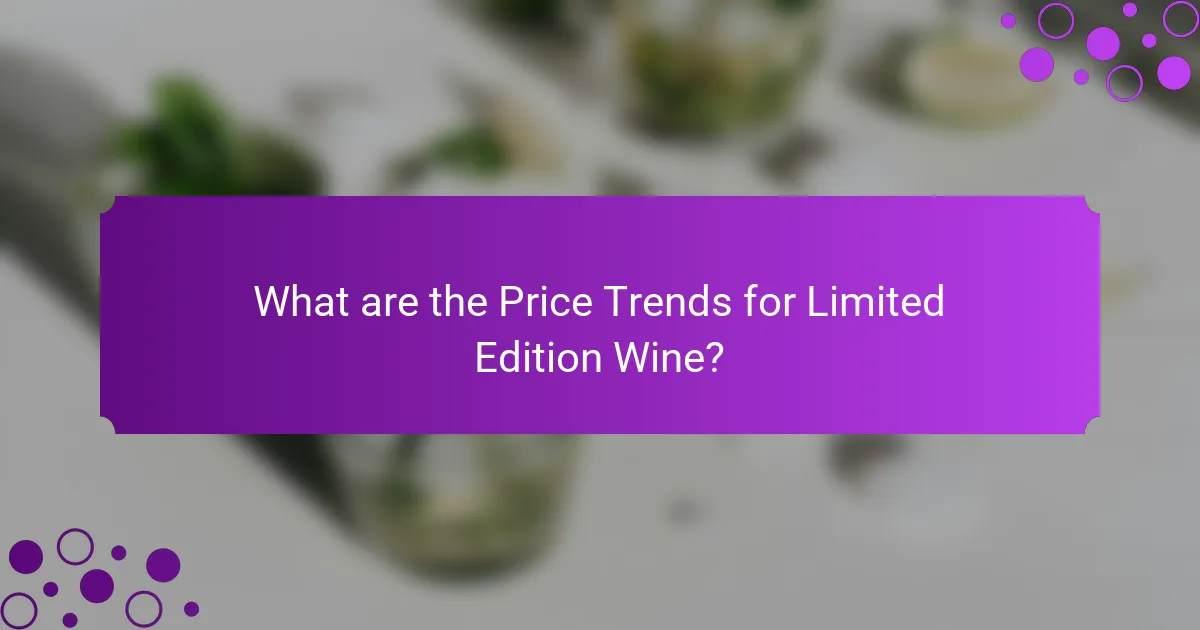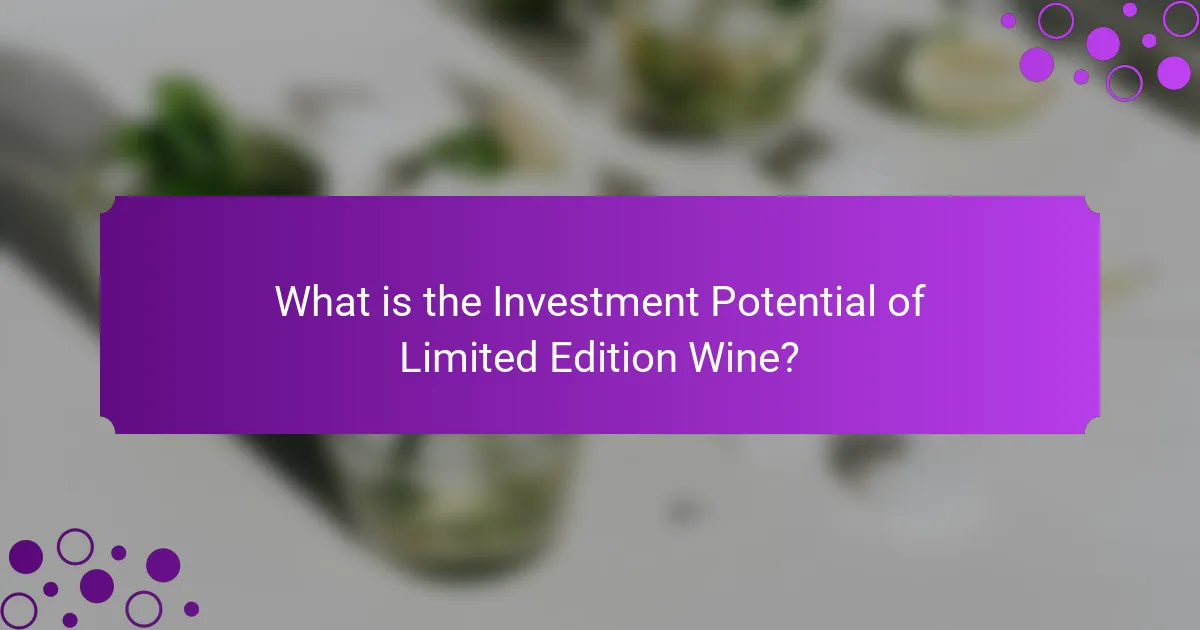
What is the Market Value of Limited Edition Wine?
The market value of limited edition wine varies significantly based on rarity, brand, and demand. Limited edition wines can sell for prices ranging from a few hundred to several thousand dollars per bottle. For instance, certain vintages from renowned wineries like Bordeaux or Napa Valley can appreciate over time. A 2010 Château Lafite Rothschild, for example, has been known to sell for over $10,000. According to the Liv-ex Fine Wine 100 index, fine wine prices have increased by 20% over the past five years, indicating strong investment potential. This trend reflects a growing interest among collectors and investors in limited edition wines.
How is the market value of limited edition wine determined?
The market value of limited edition wine is determined by several key factors. Rarity plays a significant role; limited production runs increase demand. Provenance also affects value; wines with a prestigious history are often more sought after. Condition is crucial; well-preserved bottles command higher prices. Market trends influence pricing; demand fluctuations can lead to price changes. Auction results provide insight; recent sales data can indicate current market values. Expert appraisals can help establish worth; professionals assess quality and marketability. Lastly, consumer interest impacts value; trends in wine collecting can shift perceived worth.
What factors influence the pricing of limited edition wines?
The pricing of limited edition wines is influenced by several key factors. Rarity plays a significant role; wines produced in smaller quantities tend to command higher prices. The reputation of the winery also affects pricing; established and prestigious wineries can price their wines higher due to brand recognition. Vintage quality is another factor; exceptional vintages often see increased demand and prices. Packaging and presentation contribute to perceived value; unique bottle designs can enhance desirability. Market demand fluctuates based on trends and consumer preferences, impacting pricing. Lastly, historical performance in wine auctions can set benchmarks for future pricing. These factors collectively shape the market value of limited edition wines.
How does rarity affect the perceived value of limited edition wines?
Rarity significantly increases the perceived value of limited edition wines. Limited availability creates a sense of exclusivity. Consumers often associate rarity with higher quality and prestige. This perception drives demand among collectors and enthusiasts. According to a study by the University of California, wines with limited production often sell for 30% more than their widely available counterparts. Additionally, auction results show that rare wines frequently achieve record prices. The combination of scarcity and desirability enhances investment potential. Ultimately, rarity shapes market dynamics and influences pricing strategies in the wine industry.
Why are limited edition wines considered valuable?
Limited edition wines are considered valuable due to their scarcity and uniqueness. The limited production creates a sense of rarity, making them more desirable among collectors and enthusiasts. These wines often come from prestigious vineyards or special vintages, enhancing their appeal. Historical significance can also contribute to their value; wines linked to notable events or figures are particularly sought after. Additionally, limited edition wines typically appreciate in value over time, making them attractive investments. According to a report by Liv-ex, fine wine prices increased by 13% in 2020, driven in part by limited editions. The combination of rarity, prestige, and investment potential solidifies their market value.
What role does brand reputation play in the market value?
Brand reputation significantly influences market value. A strong brand reputation enhances consumer trust and loyalty. This leads to higher demand for products. Higher demand can result in increased prices. For instance, wines from reputable brands often sell at premium prices. A study by the Wine Market Council found that brand perception impacts purchasing decisions. Consumers are willing to pay more for wines from well-regarded producers. Thus, brand reputation directly correlates with market value in the wine industry.
How do collector trends impact the value of limited edition wines?
Collector trends significantly influence the value of limited edition wines. Increased demand from collectors often leads to higher prices. Limited edition wines become sought after due to their rarity and exclusivity. As more collectors enter the market, competition drives prices up. For example, wines from prestigious vintages or renowned wineries often see substantial appreciation. Historical data indicates that certain limited edition wines can appreciate by over 200% within a decade. Additionally, social media and wine auctions amplify collector interest and visibility. This heightened awareness further elevates the perceived value of these wines.

What are the Price Trends for Limited Edition Wine?
Price trends for limited edition wine have shown a consistent upward trajectory over recent years. According to a report from Liv-ex, the fine wine market has seen an annual price increase of approximately 10% since 2010. Limited edition wines, particularly those from renowned vineyards, often appreciate even more due to their scarcity. For instance, certain vintages from Bordeaux and Burgundy have experienced price surges exceeding 20% annually. The demand for collectible wines has intensified, driven by both investors and enthusiasts. As a result, auction prices for limited editions frequently surpass their retail values. This trend indicates a growing recognition of limited edition wines as viable investment assets.
How have prices for limited edition wines changed over time?
Prices for limited edition wines have generally increased over time. This trend is driven by their rarity and collector demand. For instance, a report by Liv-ex shows that the average price of fine wine has risen by 120% over the past decade. Limited edition releases often see even steeper price appreciation. Specific wines, such as those from Bordeaux, can appreciate by over 200% shortly after release. Economic factors, including inflation and market speculation, also influence these price changes. Collectors are willing to pay premium prices, further driving up market values. Overall, the historical trend indicates a consistent upward trajectory in limited edition wine prices.
What historical data is available on price fluctuations?
Historical data on price fluctuations for limited edition wine includes auction results and market reports. Auction houses like Sotheby’s and Christie’s provide detailed records of wine prices over the years. These records show trends in price increases or decreases based on rarity and vintage quality. For example, a 2018 report by Liv-ex indicated that the average price of fine wine rose by 13% over the previous year. Additionally, wine investment platforms often publish annual performance reports, highlighting significant price changes. Such data is crucial for understanding market dynamics and investment potential in limited edition wines.
What external factors contribute to price changes in the wine market?
External factors that contribute to price changes in the wine market include supply and demand dynamics, climate conditions, and economic factors. Supply and demand directly influence pricing; when demand exceeds supply, prices typically rise. Climate conditions affect grape quality and yield, impacting availability and prices. Economic factors, such as inflation and consumer spending, also play a significant role. For instance, during economic downturns, consumers may reduce spending on luxury items like wine, leading to price declines. Additionally, geopolitical events and trade policies can disrupt supply chains, further influencing prices. Historical data shows that vintage quality and ratings from wine critics can significantly affect market prices as well.
What are the current trends in limited edition wine pricing?
Current trends in limited edition wine pricing show a significant increase in value. Limited editions are often priced higher due to their rarity and exclusivity. Recent data indicates that prices for these wines have risen by an average of 15% annually. This trend is driven by growing consumer interest in unique and collectible wines. Auction results reveal that certain limited editions can fetch prices up to three times their original retail value. Additionally, the influence of wine critics and ratings can further elevate prices. Market analysis suggests that limited edition wines are increasingly viewed as investment assets.
How do economic conditions influence current pricing trends?
Economic conditions significantly influence current pricing trends. Factors such as inflation, employment rates, and consumer confidence directly affect demand and supply. For instance, during economic downturns, consumer spending typically declines. This results in lower demand for luxury items, including limited edition wines. Conversely, during economic growth, increased disposable income can lead to higher demand and elevated prices. Historical data shows that wine prices tend to rise during periods of economic prosperity. According to the Liv-ex Fine Wine 100 index, fine wine prices increased by 20% during the economic recovery post-2008 recession. This illustrates the correlation between economic conditions and pricing trends in the wine market.
What regions are currently seeing the highest price increases?
Currently, regions such as Bordeaux, Burgundy, and Napa Valley are seeing the highest price increases in limited edition wine. Bordeaux has experienced a price surge of approximately 15% over the last year. Burgundy wines have seen even steeper increases, with some labels rising by over 20%. Napa Valley is also notable, with a reported 10% increase in average wine prices. These trends are driven by growing global demand and limited supply. Notably, the 2021 Bordeaux vintage has been highly sought after, contributing to the price hikes.

What is the Investment Potential of Limited Edition Wine?
The investment potential of limited edition wine is significant due to its rarity and demand. Limited edition wines often appreciate in value over time. For instance, certain vintages have shown an annual return of 10-15%. The rarity of these wines creates a sense of exclusivity among collectors. Market trends indicate that wines from renowned regions, like Bordeaux and Burgundy, consistently perform well. Additionally, auction results often reflect increasing prices for limited releases. The global market for fine wine reached approximately $3 billion in 2022, highlighting its investment viability. Overall, limited edition wines can serve as both a passion and a profitable investment.
How can limited edition wines serve as an investment?
Limited edition wines can serve as an investment due to their rarity and potential for price appreciation. The limited availability creates scarcity, driving up demand among collectors and investors. Historical data shows that certain limited edition wines have appreciated significantly over time. For example, the Liv-ex Fine Wine 100 index indicates that fine wine prices have increased by 185% over the last decade. Additionally, wines from prestigious regions or renowned vintners often fetch higher prices. The resale market for these wines provides liquidity, allowing investors to sell at a profit. Therefore, investing in limited edition wines can yield substantial returns when chosen wisely.
What are the risks associated with investing in limited edition wines?
Investing in limited edition wines carries several risks. One significant risk is market volatility, as wine values can fluctuate based on consumer demand and market trends. Additionally, the wine’s condition can deteriorate over time, affecting its quality and resale value. There is also the risk of counterfeit wines, which can lead to financial loss if an investor unknowingly purchases a fake bottle. Limited availability can create price inflation, but it may also lead to a sudden drop in value if interest wanes. Finally, storage costs and insurance can add to the overall investment risk, impacting profitability.
How does one assess the investment potential of a specific wine?
To assess the investment potential of a specific wine, one should evaluate its provenance, rarity, and historical performance. Provenance refers to the wine’s origin and the reputation of the producer. Wines from well-known regions and established wineries tend to have higher investment potential. Rarity plays a crucial role; limited production wines often appreciate more in value. Historical performance can be analyzed through auction results and market trends. Notably, wines that have shown consistent price increases over time are more likely to continue this trend. Additionally, one should consider expert ratings and reviews, as higher scores can enhance a wine’s desirability and market value.
What tips should investors consider when purchasing limited edition wines?
Investors should consider provenance, reputation, and market trends when purchasing limited edition wines. Provenance ensures that the wine’s history is traceable and authentic. A wine with a well-documented origin typically commands a higher value. Reputation of the winery plays a crucial role in investment potential. Wines from renowned producers often appreciate more significantly over time. Market trends must be analyzed to understand demand and pricing fluctuations. Researching recent auction results can provide insights into valuation. Additionally, storage conditions affect the wine’s quality and future value. Proper storage in a controlled environment is essential for maintaining the wine’s integrity. By following these tips, investors can make informed decisions in the limited edition wine market.
How can investors identify promising limited edition wines?
Investors can identify promising limited edition wines by assessing factors such as rarity, producer reputation, and historical price trends. Rarity increases demand and potential appreciation in value. Wines from renowned producers often have a proven track record of price stability and growth. Historical data shows that limited editions from established wineries appreciate significantly over time. Additionally, reviewing auction results can provide insights into market trends and buyer interest. Engaging with wine investment experts can also guide investors in making informed decisions.
What are the best practices for storing and maintaining wine investments?
Store wine investments in a cool, dark, and humid environment. Ideal temperatures range from 45°F to 65°F. Consistent temperatures prevent spoilage and aging issues. Maintain humidity levels between 50% and 70% to keep corks moist. Use wine racks to avoid vibration and ensure proper airflow. Store bottles horizontally to keep corks in contact with the wine. Avoid exposure to direct sunlight, which can degrade wine quality. Regularly check for signs of leakage or damage to bottles. Proper storage can enhance the value of wine investments over time.
What resources are available for tracking limited edition wine values?
Wine Market Journal provides comprehensive tracking of limited edition wine values. This resource offers historical price data and market trends. WineSearcher is another platform that aggregates pricing from various retailers. It allows users to compare prices for specific bottles. Vivino is a popular app that includes user-generated ratings and pricing. It helps collectors gauge the market value based on community input. Additionally, auction houses like Sotheby’s and Christie’s publish results from wine auctions. These results reflect the actual selling prices of limited edition wines. Lastly, specialized wine investment firms offer reports and insights on wine value trends. They analyze market conditions and investment potential.
The main entity of this article is limited edition wine, which is characterized by its rarity, brand reputation, and investment potential. The article provides a comprehensive overview of how the market value of limited edition wines is determined, highlighting factors such as rarity, provenance, condition, and market trends. It discusses the upward price trends for these wines over time and examines the significant investment potential associated with them, including the risks and best practices for investors. Additionally, it outlines the resources available for tracking the values of limited edition wines, offering insights into making informed investment decisions.